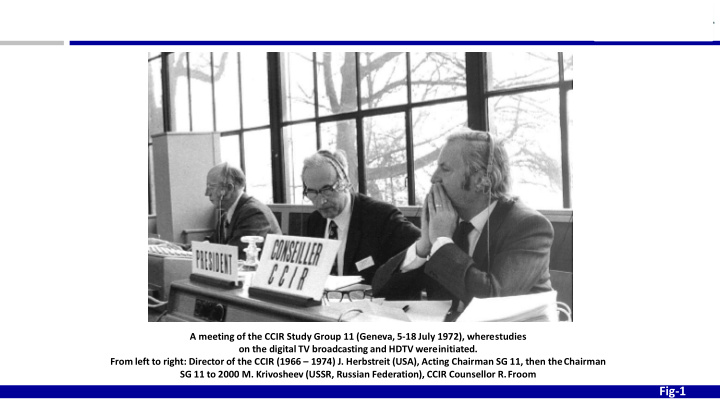



A meeting of the CCIR Study Group 11 (Geneva, 5-18 July 1972), wherestudies on the digital TV broadcasting and HDTV wereinitiated. From left to right: Director of the CCIR (1966 – 1974) J. Herbstreit (USA), Acting Chairman SG 11, then theChairman SG 11 to 2000 M. Krivosheev (USSR, Russian Federation), CCIR Counsellor R.Froom Fig-1
Documents of ITU-R SG6 QUESTION ITU-R 102-3/6 Methodologies for subjective assessment of audio and RESOLUTION ITU-R 4-7 video quality (1999-2011-2014-2015) … Structure of Radiocommunication Study Groups (1993- k) that the reception part of the end-to-end 1995-1997-2000-2003-2007-2012-2015) programme chain has a major influence on the final … perception of the content and that the influences in the STUDY GROUP 6 reception part can include the technology used and the (BROADCASTING SERVICE) setting of personal preferences by the end-user, The Study Group, recognizing that radiocommunication 7. What ways could be used for video and audio broadcasting extends from the production of programmes quality assessment taking into account the strong to their delivery to the general public, as detailed above, interrelation between the source signal of a broadcasting studies those aspects related to production and programme and its processing and presentation on the radiocommunication, including the international exchange reception end? of programmes as well as the overall quality of service. Fig-2
The slogans of the first interactive Telecom 97 1. “It is now crystal clear that the formulation for strategy for further progress in telecommunications is inconceivable without a comprehensive and fundamental solution to the problems of interactivity” Prof. Mark Krivocheev, NIIR, Russian Federation. 2. “Multimedia has become a key-element of the currently emerging information society” Philippe Douste-Blazy, Minister of Culture, France 3. “New initiatives around the world talk of building an ‘information highway’ . But what is the appropriate policy response, and how can we ensure that this new infrastructure is truly international?” Pekka Tarjanne, Secretary General, ITU 4. “In the 21 st century, the capacity to communicate will almost certainly be a key human right. Eliminating the distinctionbetween information rich and information poor countries is also critical to improving the quality of life of all humanity” Nelson Mandela, President, South Africa 5. “We can now at last create a planetary information network that transmits messages and images with the speed of light from the largest city to the smallest village on every continent. To accomplish this purpose, legislators, regulators, and business people must do this: build and operate a Global Information Infrastructure” Al Gore, US Vice-President Fig-3
СHAIRMAN OF ITU -R SG6 (BROADCASTING SERVICE) А.Мagenta ( Italy ) С.Dosh ( Germany ) Y.Nishida ( Japan ) 2000-2007 гг. 2008-2015 гг. 2016 – to present Fig-4
E. Metzler L. Hayes J. Herbstreit Van der Pol (Switzerland) (Great Britain) (USA) (Netherlands) (1956 – 1963) (1963 -1966) (1966 – 1974) (1948 – 1956) R. Kirby R. Jones V. Timofeev F. Rancy (USA) (Canada) (RussianFederation) (France) (1974 – 1992) (1993 – 2002) (2003 – 2010) (2011 - … ) Fig-5
CCIR VII Plenary Assembly (London, 3 September – 7 October 1953). From left to right: I.A. Cintovatov, Chief of International Department of USSR Ministry of Communications, Head of USSR delegation ; M.I. Krivocheev, Head of department TV, VHF-FM broadcasting and radio relay lines of Radiodepartment of USSR Ministry of Communications, expert of delegation Fig-6
Recommend
More recommend